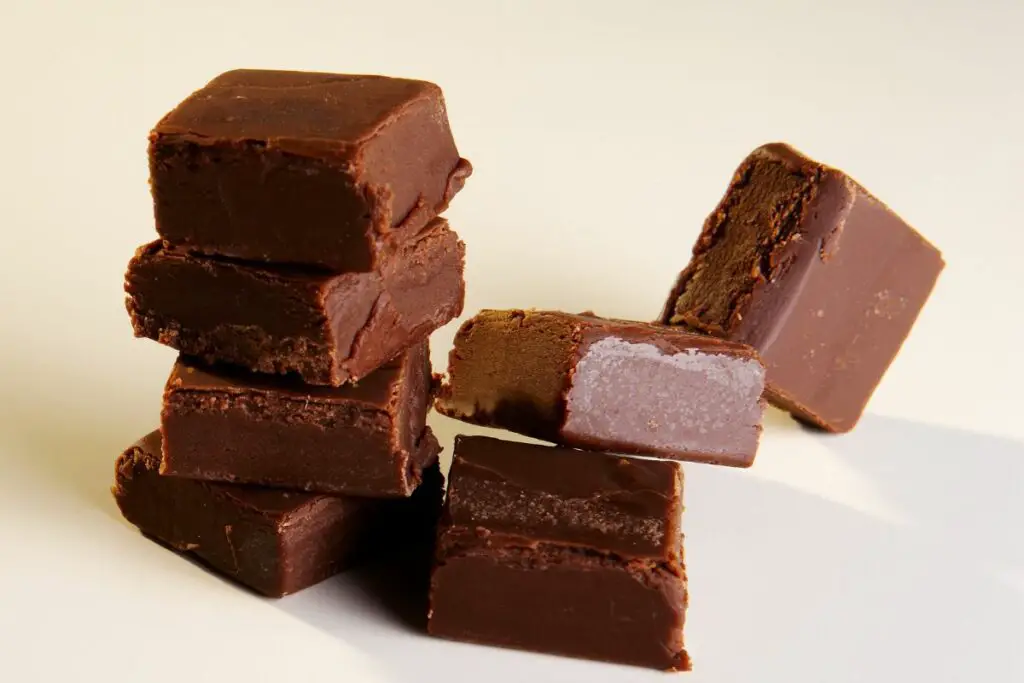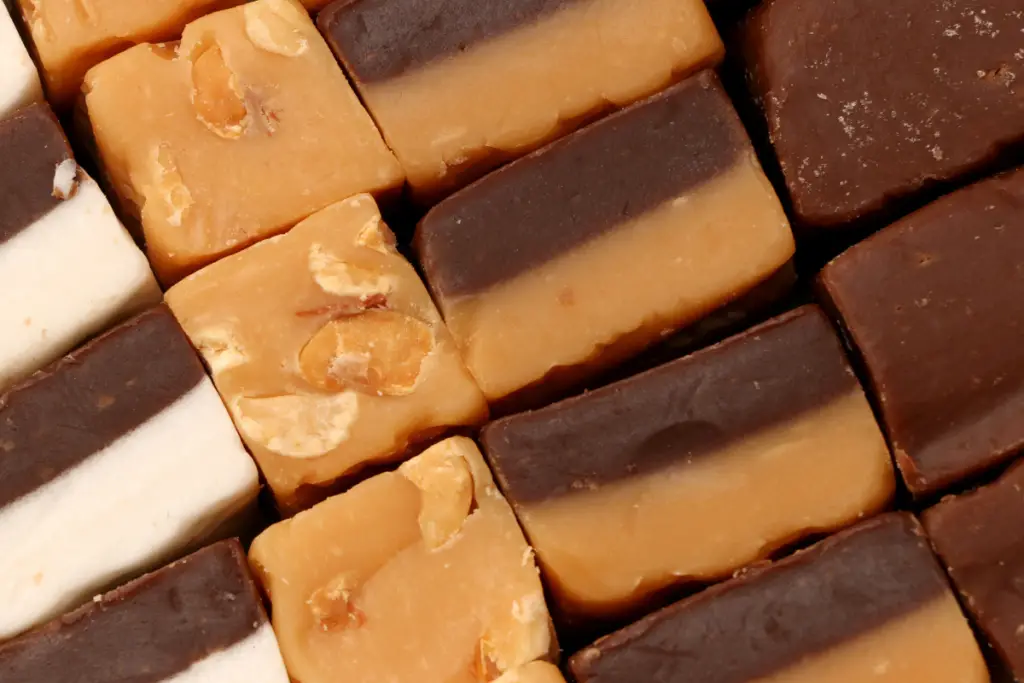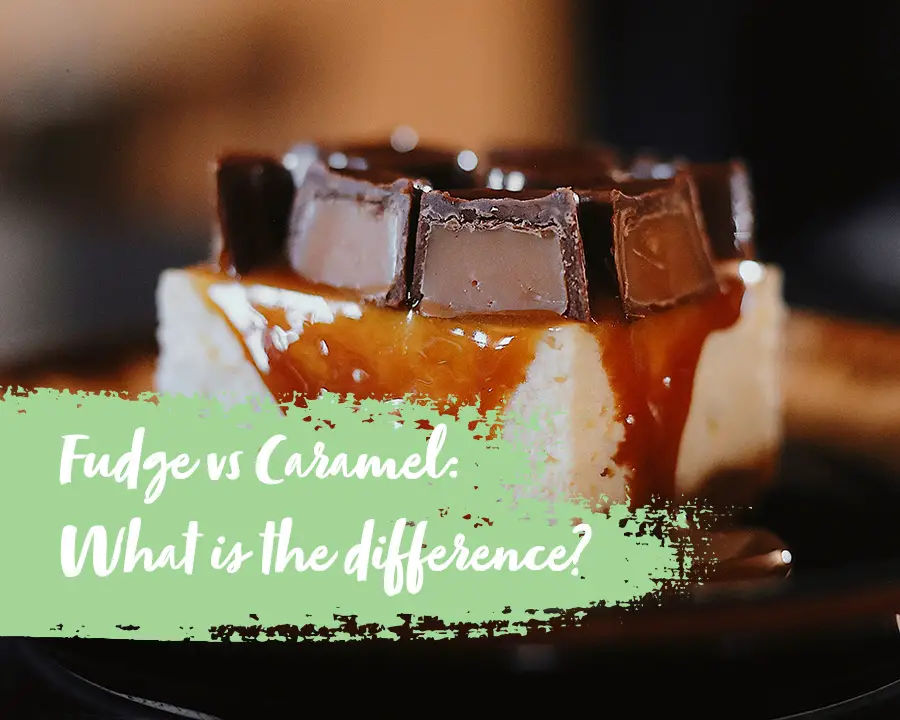If you’re like most of us, then you love a sweet treat every now and again. Two favorite treats are fudge and caramel.
Whether you eat them on their own or part of a dessert, these sweet delights tingle our taste buds every time.
However, many people find it hard to distinguish between caramel and fudge, thinking they are pretty similar in terms of taste and texture.
After all, they can both be used as sauces on desserts, such as ice cream. And, they come in hard and soft forms for everyone to enjoy. They even look the same with a light-amber color!
The truth, however, is that fudge and caramel do differ in numerous ways. Today, we are going to delve into these differences so you can finally understand what fudge and caramel are and how they are unique from one another.
You may also be wondering what the differences are between Dulce De Leche and caramel, check out our blog article covering this.
All about fudge

Fudge is typically composed of butter, sugar, and milk. It is usually heated up to a soft-ball temperature of between 224 and 238 degrees Fahrenheit.
Its mixture is then beat whilst it cools down until it reaches that iconic creamy, smooth consistency. Texture-wise, fudge is somewhere between hard caramels and fondant icing.
Soft, chewy, or crumbly, fudge comes in a few forms but is also made by mixing butter and sugar with either cream or milk.
Often described as a type of fondant, the main ingredient in fudge is typically chocolate, milk or cream, but it is not essential.
Other ingredients can also be used, including nuts, fruits, caramel (confusing, right?), or other flavors in the fudge mixture.
The creaminess of fudge texture is usually determined by the sugar crystallization. But, it is critical to pay close attention to the temperature you cook fudge at as it may become brittle and hard if left for too long at high temperatures.
Fudge is available in a variety of flavors, with some of the most popular being:
You can also enjoy hot fudge which is somewhat different to confectionery fudge. Hot fudge tends to be thick and chocolate flavored, usually being used as a topping on ice cream.
All about caramel
Caramel is a candy that most of us adore. Unlike fudge, though, it is heated to a higher temperature of around 340 degrees Fahrenheit.
As the main ingredient in caramel, sugar is gradually heated to this temperature, molecules begin to break down, forming new compounds. These produce rich, deep flavors and the color transforms in a golden brown.
This whole process is known as caramelization and can be done with a range of different sugars.
Caramel is often mixed with cream and/or other ingredients to produce caramel candy or sauce. You may have enjoyed caramel on an assortment of treats, including apples during fall.
Moreover, the caramelization process typically produces a bitterness that can put some people off the taste of caramel.
However, this bitterness can be offset with a simple pinch or two of salt, a common method used by caramel manufacturers. Salt can be added to the top of caramel candies or combined with a caramel sauce.
Other caramel-flavored treats that are popular include caramel-flavored coffees and hot cocoas. Salted caramel drinks have also grown in popularity over the years and are enjoyed worldwide today.
Main Differences Between Fudge And Caramel

Temperature When Cooked
We have already touched upon some of the distinctions between fudge and caramel above. For instance, both are cooked at different temperatures.
Fudge is usually cooked at a soft-ball temperature, ranging between 224 and 238 degrees Fahrenheit. Caramel, on the other hand, is traditionally cooked at a higher temperature of at least 340 degrees Fahrenheit.
Ingredients
Another key difference is the ingredients used in the making of fudge and caramel. Whilst both are variations of cooked sugar, they are mixed with different ingredients. Why? To achieve different consistencies.
Sugar cooked at a high temperature with butter and milk or cream will create fudge, whereas caramel is made when granulated sugar is heated slowly to 340 degrees Fahrenheit.
This gradual heating process helps to break down the molecules in the sugar, creating that famous deep, brown hue and rich flavor.
Texture
There is also a difference in texture. Fudge is traditionally firm, but not very hard. Whilst it can be sticky, most of the time, you want your fudge to remain quite rigid and not soft or syrupy.
Although you can get crumbly or brittle fudge, the standard texture shouldn’t be too grainy or lumpy. Instead, it is usually smooth.
As for traditional caramel, its consistency is typically quite sticky. As you eat it, it tends to get stickier inside your mouth, too. It shouldn’t have a grainy texture.
If it does, the sugars have crystallized too much. In truth, there are actually a range of caramel textures.
Some are glassy or hard, such as hard candies, whilst others are soft and runny, such as caramel sauce. The majority of caramel treats are soft enough to chew, but hard enough to maintain their form.
When making fudge, many people find that they end up making caramel instead. If you have had this issue, check out our article here on why your fudge delight has turned into an unwelcome caramel shock!
Taste
You can be forgiven for thinking that fudge and caramel have similar flavors, but they also differ in this department.
Chocolate is generally the base ingredient for fudge candy, but many other ingredients can also be used. Some examples include vanilla, maple, marshmallow cream, peanut butter, and butterscotch.
As you can imagine, the flavor of the fudge will depend on the ingredients used. This is why various flavored fudges are used as ice cream toppings and cake icings.
In the traditional sense of the word, fudge tastes similar to a sweet piece of confectionery with a slight crumbly texture.
But, with over 81 different flavors available and seemingly endless combinations, you can get fudge to taste like just about anything!
Caramel has a much sweeter, richer flavor profile compared to fudge. When you have an almost 100 percent caramelized sugar treat, it will have a very strong, bitter taste.
You may find the caramel color in various recipes but this is typically used to color the food, rather than flavor it.
We would argue that caramel has an almost buttery flavor, sharing characteristics with butterscotch flavorings and candy.
But, it can also be creamy with notes of dairy. The higher the temperature caramel is cooked at, though, the less sweet and more complex it will taste.
In Summary
As you can see, fudge and caramel have many similarities but just as many differences. From texture to ingredients and cooking methods to taste, both of these treats are unique in their own right.
Let us know which you prefer – fudge or caramel?
If you love fudge more than caramel then check out our fudge recipes:


